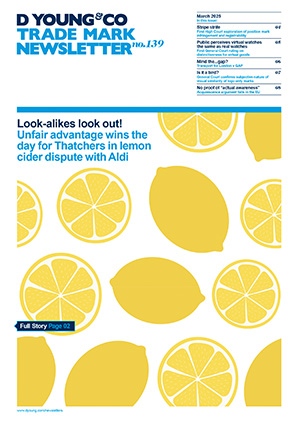No EUIPO green light for colour combination mark(s): MARQUES and INTA see red
Trade mark associations (MARQUES and the International Trade Mark Association) have intervened in a General Court case on the registrability of a colour combination mark.
OMV Aktiengesellschaft, an Austrian oil and gas company which operates fuelling stations, filed for EU designation of international registration no. 1593116 on 27 January 2021. The mark consists of a combination of gentian blue and yellow green, in a ratio of 1:7, separated horizontally, that is, a thin green line and a thick line in blue above it, as shown below:

The European Union Intellectual Property Office (EUIPO) partially refused registration of the sign for goods and services in classes 1, 4, 35, 37 while accepting registration for other services in classes 35, 37, 39, 40, 42, 43 and 44. The Board of Appeal confirmed the examiner’s decision. The case is now pending before the General Court. Marques and INTA, in support of OMV’s appeal, filed statements in intervention. The highly anticipated decision will be an important step in the development of EU trade mark law.
Registrability of colour marks
The Court of Justice of the European Union (CJEU) and the General Court hold the view that, in principle, single colour marks are non-distinctive and only registered in exceptional cases or upon acquired distinctiveness. This is due to the limited availability of colours and the risk of monopolisation of them. Further, single colours are found not capable of indicating origin, and consumers are not used to inferring the commercial origin based on colours.
The EUIPO agrees with this principle regarding single colours but, according to the current guidelines, finds colour combination marks generally acceptable unless specific facts or arguments warrant a refusal.
The Board of Appeal’s decision
In the OMV decision, however, the EUIPO rejected registration of a colour combination mark, relying on the principle that “distinctiveness without any prior use is inconceivable save in exceptional circumstances”. It found that the colours blue and green were basic and simple colours, and common in the field of business as they stood for certain concepts and qualities (for example, blue signifies the ocean, sky, and reliability while green evokes ecology, normal, and positive. Both colours suggest environmentally friendly). Therefore, individually, the colours were non-distinctive. Their combination was not more than the sum of its elements and would primarily be perceived as serving aesthetic purposes. OMV’s surveys on the distinctiveness were only relevant regarding the subsequent claim of acquired distinctiveness but not for the question of inherent distinctiveness.
Intervention of MARQUES and INTA
To summarise the interveners’ arguments, they found that colour combinations required a different threshold for registrability than single colour marks. The arguments for the strict handling of single colour marks could not be transferred. The Board of Appeal disregarded that the application consisted of 1) specific colours (hues), 2) in combination, and 3) a systematic arrangement. This came with a higher level of distinctiveness and posed a lesser risk for monopolisation. With such a colour combination a nuanced and specific communication was possible. The fact that the colours occurred in nature did not render them non-distinctive. Further, it was established practice that petrol stations used colours to distinguish their services, which was relevant for the public’s perception and the inherent distinctiveness. In general, the argument that colours are not perceived as origin indicators lacked evidence.
Mere speculations as to the association of colours were not enough to shift the burden to establish distinctiveness to the applicant.
Outlook
When it comes to colour combination marks, a specific and fact-based framework, taking into account an established market practice, would be needed to provide certainty for market operators. Currently, supposed ideas associated with colours are given so much weight that, on that basis, any colour combination could, and is, easily refused registration. As poetic as this allegorical approach might be, colour combinations can effectively differentiate the origin of goods and services, and the risk of monopolisation of colours is reduced.
With the intervention of MARQUES and INTA, the spotlight is now on the General Court, which will (hopefully) pave the way for a specific and fact based framework for assessing the inherent distinctiveness of colour combination marks.
Case details at a glance
Jurisdiction: European Union
Decision level: EUIPO Board of Appeal
Parties: OMV Aktiengesellschaft v EUIPO
Date: 08 November 2023
Citation: R 798/2023-5
Useful links
- INTA Amicus Brief: T-38/24, OMV AG v EUIPO, 24 July 2024: dycip.com/t-38-24-inta-brief
- MARQUES Statement in intervention T-38_24: OMV v EUIPO, 16 July 2024: dycip.com/marques-t-38-24
- 14.2 Colour combinations, EUIPO: dycip.com/euipo-colour-combinations

